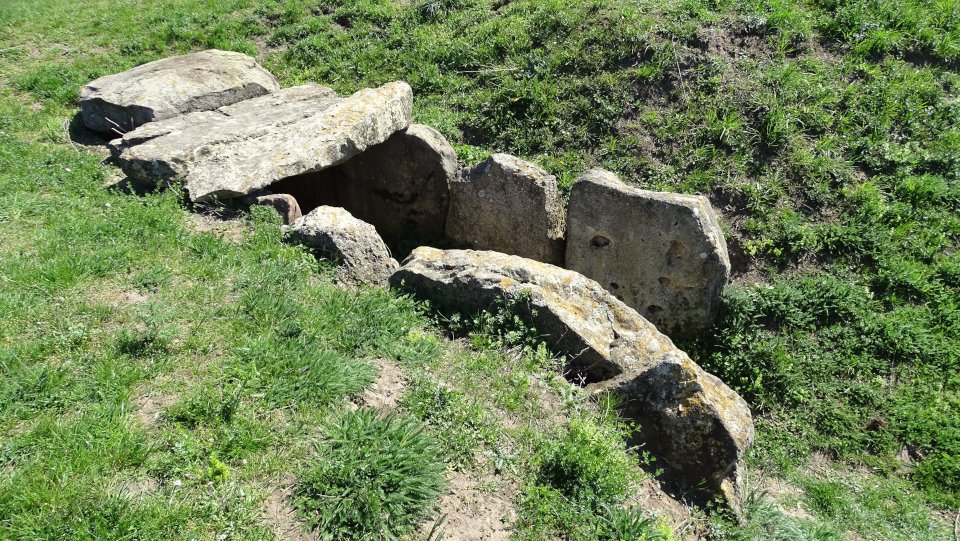






The tomb lies under a beautiful old oak tree
Visited May 2019


possible view of the tomb in the Neolithic period
Visited May 2019

Reconstruction attempt in the plan
Visited May 2019

Sketch from the excavation diary of Friedrich Klopfleisch 1877
Visited April 2019
The princely tomb of Leubingen is the largest surviving Early Bronze Age princely tomb of the Aunitzitzer culture. It is located near Leubingen, a district of Sömmerda (Thuringia). The princely tombs of the Aunetitzer culture form a special type of graves, which stands out from the normal burials of this culture by huge, widely visible burial mounds with rich grave goods and which was the reason to call a whole culture as Leubing culture.
The mound lies east of the A71 motorway services Leubinger Fürstenhügel. From Leubingen take the (signed) Stödtener Strasse southeast. Around 300 m after you cross the A71, the mound lies right beside the road.
Visited April 2019





The megalithic tomb Langeneichstädt (also stone cist of Langeneichstädt) is a Neolithic grave of the type Middle German chamber (also called sunken chamber or gallery grave), a rather rare megalithic form in Germany. It was discovered in 1987 during fieldwork near the medieval Eichstädter Warte and became an outstanding megalithic object in Saxony-Anhalt.
The stone tomb (5.3 m long, 1.9 m wide and 1.7 m high) is dated 3,600 to 2,700 BC. As a capstone of the chamber, a 1.76-meter-tall menhir statue with a carved, highly stylized face was used, which is interpreted as representing a dolmen goddess (female deity). A replica of the menhir was erected at the burial chamber. The original is shown in the Halle State Museum of Prehistory.
The megaltithic tomb is together with the finding place of the Nebra sky disk, the circular ditch enclosures of Pömmelte and Gosek and the Halle State Museum of Prehistory a station on the tourist road Himmelswege (Celestial Pathways).
The tomb is located about 800 m north of Langeneichstädt and about 30 m northwest of the Eichstädter Warte and together with this on a hedged meadow area. Drive on the Friedenstraße (L177), right in the middle of Langeneichstädt take the Wartenweg northward. Drive on this road, cross a railway and after about 1.5 km turn left. Drive towards the Eichstädter Warte for about 350 m and you’ll find the car park for the site.
Visited April 2019










A replica of the 1.76 m long mehir Dolmen Goddess
Visited April 2019

The Goseck circle (German: Sonnenobservatorium Goseck) is a Neolithic structure in Goseck in the Burgenlandkreis district in Saxony-Anhalt, Germany. Its construction is dated to approximately 4,900 BC, and it seems to have remained in use until about the 4,700 BC. It may thus be the oldest and best known of the circular enclosures associated with the Central European Neolithic.
The site consists of an approximately circular ring trench with a diameter of approx. 71 m. In the two palisades there are three access routes, which are aligned to the north, southwest and southeast. The gates of the inner palisade, about 49 m in diameter, are narrower than those of the outer palisade, which has a diameter of about 56 m.
The circular ditch enclosure is together with the finding place of the Nebra sky disk, the circular ditch enclosure of Pömmelte, the megalithic tomb Langeneichstädt and the Halle State Museum of Prehistory a station on the tourist road Himmelswege (Celestial Pathways).
The site is located on the northwest outskirts of Goseck, there is a car parking and an access path in the north of Gosek.
In the castle of Gosek there is an interesting exhibition on the Gosek circle and other circular ditch enclosures.
Visited April 2019
The reconstructed circular ditch enclosure Pömmelte is a unique example of prehistoric religious buildings. Farmers and warriors built this complex monument at the end of the Stone Age some 4,300 years ago – around the same time as Stonehenge, as a complex ritual site where a variety of religious activities were practiced. The entrances are astronomically aligned on important dates of the agricultural calendar. Since December 2015 the complex bears the name “Ringheiligtum Pömmelte” (ring sanctuary Pömmelte).
The entire complex has a diameter of about 115 m, with the circular ditch, which is a cult place from the end of the 3rd Millennium BC, has a diameter of about 80 m.
The circular ditch enclosure is together with the finding place of the Nebra sky disk, the circular ditch enclosure of Goseck, the megalithic tomb Langeneichstädt and the Halle State Museum of Prehistory a station on the tourist road Himmelswege (Celestial Pathways).
Drive from Schönebeck on the L51 in the direction of Pömmelte and follow the road about 2 kilometers to the complex, which is signed from the road.
A must see site for every Modern Antiquarian :-)!